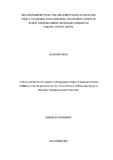| dc.description.abstract | Globally, researchers have demonstrated the fact that heads of schools have a duty to
provide children with a safe, secure, and peaceful environment in which learning can
occur (Ministry of Education, Guyana, 2017). However, it is unfortunate that there have
been occurrences of various incidences that seem to affect student safety in institutions
of learning, as indicated by the inspection reports (Nakuru County Education Office,
2020). The purpose of this study was to establish the relationship between the
implementation of selected Safety Standards and Guidelines and student safety in Public
Mixed Boarding Secondary Schools in Nakuru County, Kenya. The objectives of the
study were to: find out the relationship between the implementation of Safety Standards
and Guidelines for Physical Infrastructure; School Grounds; Drug and Substance Abuse,
and Food Safety and student safety in public mixed boarding secondary schools in
Nakuru County. The study adopted a descriptive survey design. Krejcie and Morgan
(1970) sample determination table was used to determine the sample size for students
and comprised 327 form 4 students. Out of the 16 schools, 2 had 2 deputy principals
each, thus bringing the number to 18. A census approach was used whereby all 16
principals and 18 deputy principals were used for the study. The study population was
clustered into 9 sub-counties. A stratified sampling technique was used to categorise the
population into three strata, namely, principals, deputy principals, and form 4 students.
Principals and deputy principals were selected using a purposive sampling technique,
while the students were selected using a simple random sampling technique. Data from
students was collected by the use of questionnaires, while that from principals and
deputy principals was collected using interviews. In addition, an observation checklist
was used to determine the level of implementation of the selected Safety Standards
Guidelines in the schools. Prior to use, the instruments were subjected to validity checks
with the help of university supervisors and reliability tests guided by the 0.7 Cronbach‟s
Alpha Reliability Coefficient level. SPSS version 22 was utilised for data analysis. The
analysis involved the computation of descriptive statistics: frequencies, percentages, and
inferential statistics. The data was then presented in tables and textually. The study found
that the implementation of Safety Standards and Guidelines for School Grounds and
Food Safety have a statistically significant relationship on student safety. The study
established that implementation of Safety Standards and Guidelines for Physical
Infrastructure and Drug and Substance Abuse do not have a statistically significant
relationship on student safety. The school management should consider mobilising
resources for enhancing the safety of school infrastructure, school grounds and food in
compliance with the safety standards and guidelines. This study is significant because it
brings to light that the implementation of selected Safety Standards and Guidelines has a
statistically significant relationship with student safety in public mixed-boarding
secondary schools in Nakuru County, Kenya. The researcher adhered to all ethical
considerations of research. | en_US |

